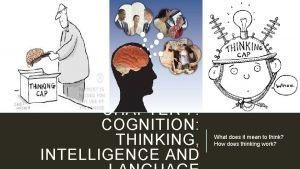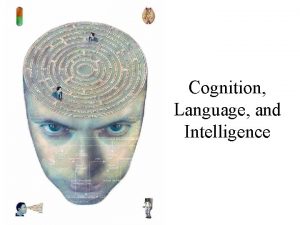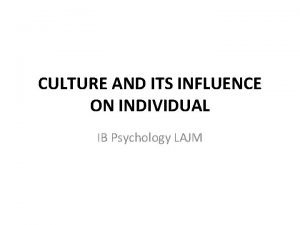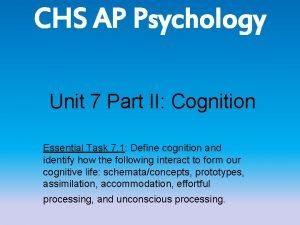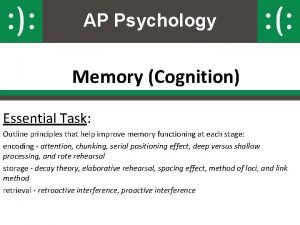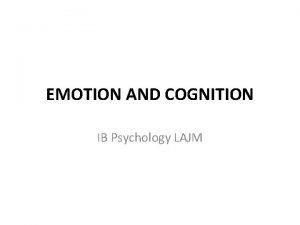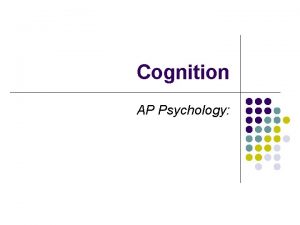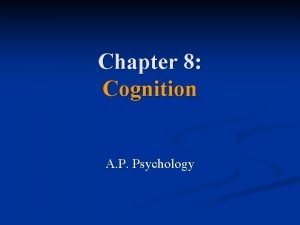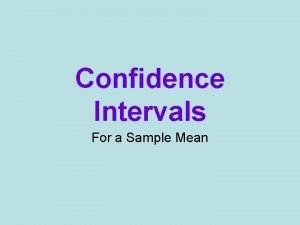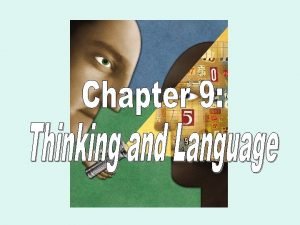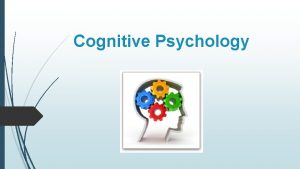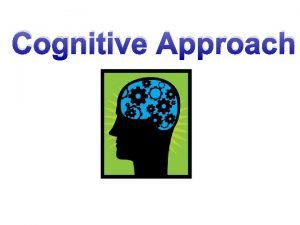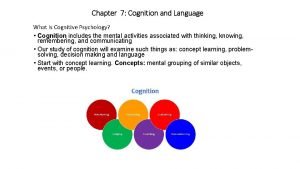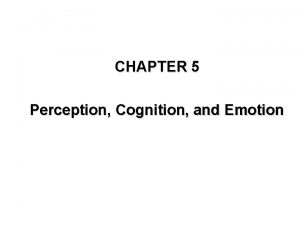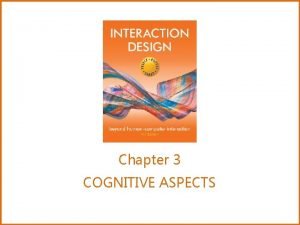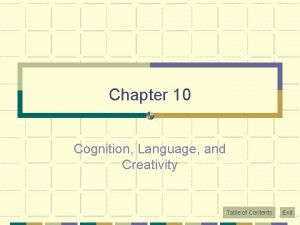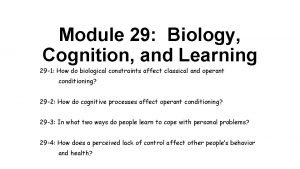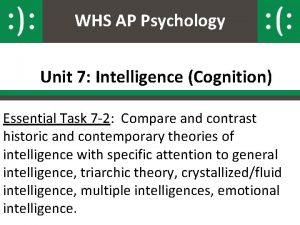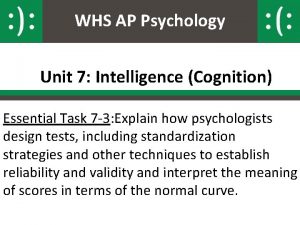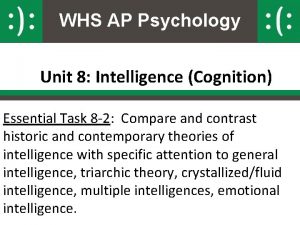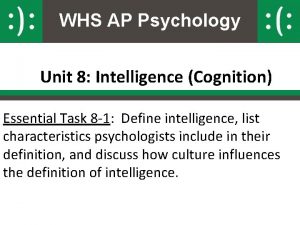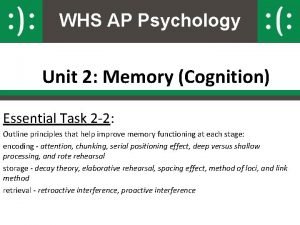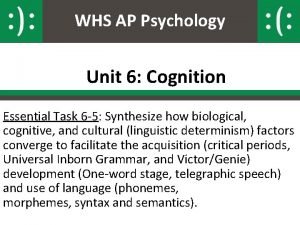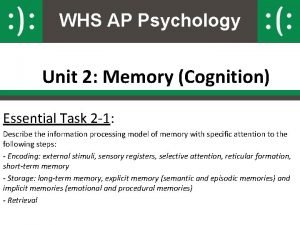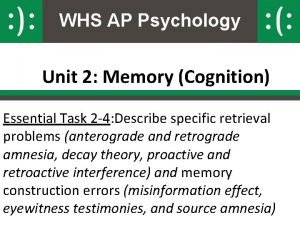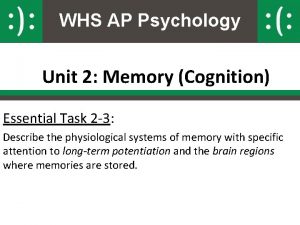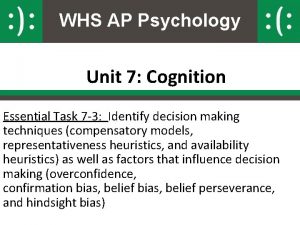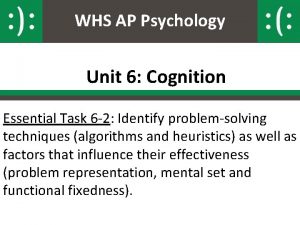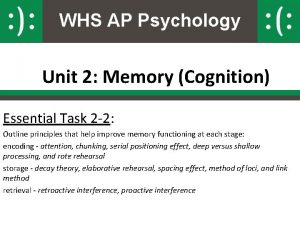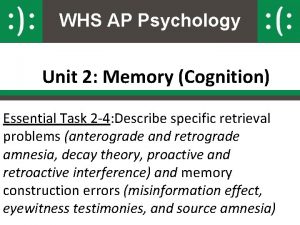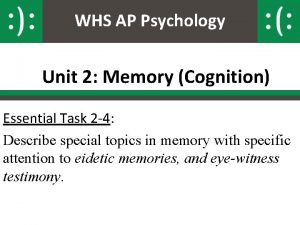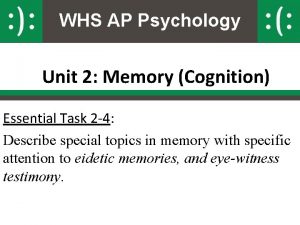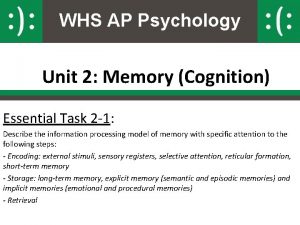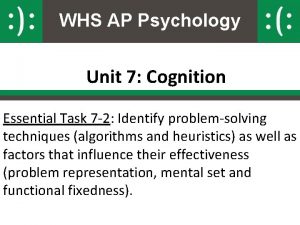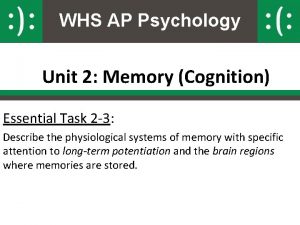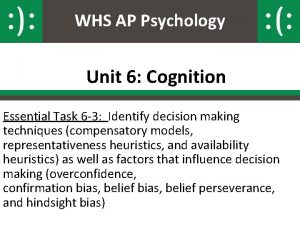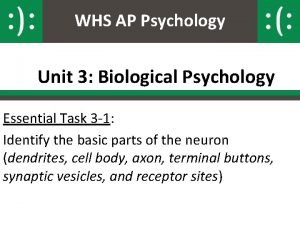WHS AP Psychology Unit 8 Intelligence Cognition Essential




























- Slides: 28

WHS AP Psychology Unit 8: Intelligence (Cognition) Essential Task 8 -2: Compare and contrast historic and contemporary theories of intelligence with specific attention to general intelligence, triarchic theory, crystallized/fluid intelligence, multiple intelligences, emotional intelligence.

Mental Retardation We are here Savants General Intelligence Influences Giftedness Triarchic Theory Special Topics Intelligence Theories Stanford. Binet WISC/ WAIS Culture Fair Multiple Intelligences Emotional Intelligence IQ Tests Psychometrics Crystallized and Fluid intelligence Reliability Standardization Validity

Essential Task 8 -2: Outline • • • General intelligence Triarchic theory Crystallized vs. fluid intelligence Multiple intelligences Emotional intelligence

General Intelligence • Theorist: Charles Spearman (1904) • Also called g factor • According to Spearman, this g factor was responsible for overall performance on mental ability tests.

General Intelligence • How did he prove it? Spearman used factor analysis to find correlations among tests of different cognitive tasks. • Technical definition: The g factor is a variable that summarizes positive correlations among different cognitive tasks, reflecting the fact that an individual's performance at one type of cognitive task tends to be comparable to his or her performance at other kinds of cognitive tasks. • Huh? If you are good at intelligent you will be good at many things.

Triarchic theory • Theorirst – Robert J. Sternberg (1985) • More of a cognitive look at intelligence rather than a psychometric focus. • Sternberg’s theory of intelligence is made up of three parts – Analytic – Creative – Practical

Triarchic Theory: Analytic • Academic problem solving skills • similar to the standard psychometric definition of intelligence e. g. as measured by Academic problem solving: analogies and puzzles, and corresponds to his earlier componential intelligence. • Sternberg considers this reflects how an individual relates to his internal world.

Triarchic Theory: Creative • insights, synthesis and the ability to react to novel situations and stimuli. • Sternberg considers this the Experiential aspect of intelligence and reflects how an individual connects the internal world to external reality.

Triarchic Theory: Practical Intelligence • (a) adaptation to the environment in order to have goals met • (b) changing the environment in order to have goals met • (c) or, if (a) and (b) don't work moving to a new environment In which goals can be met • People with this type of intelligence can adapt to, or shape their environment.

Crystallized vs. Fluid Intelligence • Theorist: R. B. Cattell (1971) • Identified two clusters of mental abilities – Crystallized intelligence one’s lifetime of intellectual achievement, as demonstrated largely through one's vocabulary and general knowledge – Fluid intelligence the capacity to think logically and solve problems in novel situations, independent of acquired knowledge. • Crystalized intelligence increases with age while fluid intelligence decreases in old age.

Multiple Intelligences • Theorist: Howard Gardner – 1980 s • the extent to which humans possess different kinds of minds and therefore learn, remember, perform, and understand in different ways, “ • 9 Intelligences

Multiple Intelligences • 1. Naturalist Intelligence (“Nature Smart”) • 2. Musical Intelligence (“Musical Smart”) • 3. Logical-Mathematical Intelligence (Number/Reasoning Smart) • 4. Existential Intelligence (Phil Smart) • 5. Interpersonal Intelligence (People Smart”) • 6. Bodily-Kinesthetic Intelligence (“Body Smart”) • 7. Linguistic Intelligence (Word Smart) • 8. Intra-personal Intelligence (Self Smart”) • 9. Spatial Intelligence (“Picture Smart”)


HISTORICAL OVERVIEW • 1990 – Salovey & Mayer coin term “emotional intelligence • “it is an intelligence that involves the ability to monitor one’s own and others’ feelings and emotions, to discriminate among them, and to use this information to guide one’s thinking and action. ” • 1995 - Daniel Goleman publishes “Emotional Intelligence. ”

GOLMAN’S THEORY • THE BRAIN HAS EMOTIONAL ARCHITECTURE – Limbic structures generate feelings & emotions – Reptilian brain downshift as the amygdala performs “neural hijacking”

COMPONENTS OF E. I. • Self-Awareness • Self-Management or trustworthiness • Motivation or resilience • Empathy or recognizing emotions in others • Social skills or handling relationships

COMPONENTS OF E. I. • FIRST THREE ARE PERSONAL – SELF-AWARENESS – SELF-REGULATION – MOTIVATION • LAST TWO ARE SOCIAL – EMPATHY – SOCIAL SKILL

SELF-AWARENESS • “THE ABILITY TO RECOGNIZE AND UNDERSTAND YOUR MOODS, EMOTIONS, AND DRIVES, AS WELL AS THEIR EFFECTS ON OTHERS • Do I know how I’m coming off in this situation?

SELF-REGULATION • “THE ABILITY TO CONTROL OR REDIRECT DISRUPTING IMPULSES AND MOODS OR THE ABILITY TO SUSPEND JUDGMENT TO THINK BEFORE ACTING. ” • Can I stop the R brain downshifting?

SELF-REGULATION • ABILITY TO RELAX • ABILITY TO MANAGE STRESS • ABILITY TO CONTROL MOODS • ABILITY TO RECOVER FROM EMOTIONAL UPSET MORE QUICKLY • ABILITY TO EMPLOY THE 6 SECOND PAUSE

SELF-REGULATION • PEOPLE WHO SELF-REGULATE – CREATE AN ATMOSPHERE OF TRUST AND FAIRNESS – REDUCE EMOTIONAL REACTIVITY IN ENVIRONMENT

MOTIVATION • “A PASSION TO WORK FOR REASONS THAT GO BEYOND MONEY OR STATUS” • JOB CAPABILITIES – Achievement drive – Commitment – Initiative – Optimism


EMPATHY • “THE ABILITY TO UNDERSTAND THE EMOTIONAL MAKE-UP OF OTHER PEOPLE. ”

EMPATHY • ABILITY TO TAKE OTHER’S PERSPECTIVE • CARING ATTITUDE • CAN BETTER READ VERBAL & NONVERBAL CUES • ATTUNED TO NEEDS & EMOTIONS OF OTHERS

EMPATHY • EMPATHY BUILDS ON SELFAWARENESS. • THE MORE OPEN WE ARE TO OUR OWN EMOTIONS, THE MORE SKILLED WE ARE IN READING OTHERS’ EMOTIONS

SOCIAL SKILLS • “PROFICIENCY IN MANAGING RELATIONSHIPS AND BUILDING NETWORKS. ” • Using your empathetic knowledge

ASSESSMENT INSTRUMENTS • Work Profile Questionnaire—EI Version • Emotional Competence Inventory 360 • Emotional Intelligence Appraisal • Bar. On Emotional Quotient Inventory • Mayer-Salovey-Caruso-EI Test
 Cognition ap psych definition
Cognition ap psych definition Chapter 7 cognition thinking intelligence and language
Chapter 7 cognition thinking intelligence and language Chapter 7 quiz cognition thinking intelligence and language
Chapter 7 quiz cognition thinking intelligence and language Cognition language and intelligence
Cognition language and intelligence Effect of culture on cognition ib psychology
Effect of culture on cognition ib psychology Embodied cognition ap psychology definition
Embodied cognition ap psychology definition Priming memory examples
Priming memory examples Emotion and cognition ib psychology
Emotion and cognition ib psychology Embodied cognition ap psychology
Embodied cognition ap psychology Representative heuristic
Representative heuristic Embodied cognition ap psychology
Embodied cognition ap psychology Wwusd
Wwusd Confidence interval assumptions
Confidence interval assumptions Model whs act
Model whs act Swms meaning
Swms meaning Study whs
Study whs Characteristics of lipids
Characteristics of lipids Cognition refers to
Cognition refers to Mental.status exam
Mental.status exam Loose thought process
Loose thought process What is cognition
What is cognition Cognition definition
Cognition definition What is cognition
What is cognition Cognition vs perception
Cognition vs perception Altered cognition in older adults is commonly attributed to
Altered cognition in older adults is commonly attributed to What is cognition
What is cognition Cognition definition
Cognition definition Module 29 biology cognition and learning
Module 29 biology cognition and learning Limited social cognition
Limited social cognition


